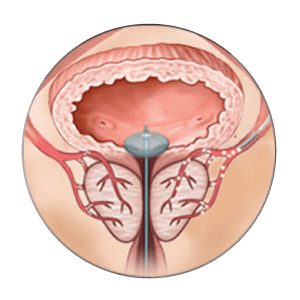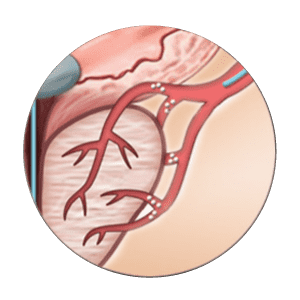Prostate Center Paris
Enlarged prostate treatment : Prostate Artery Embolization (PAE)
Prostate embolization: a new treatment for prostatic hypertrophy
Prostate artery embolization : the procedure :
Prostate artery embolization is an advanced medical procedure to treat Benign Prostatic Hyperplasia (BPH). The general procedure is as follows:
- Preparation: Before the operation, the patient undergoes blood tests, medical images and sometimes an ultrasound scan of the prostate. These tests help determine the exact size and location of the adenoma.
- Local anesthesia: In most cases, prostate artery embolization is performed under local anesthesia. However, in some cases, a general anaesthetic may be used, depending on the preferences of the patient and the medical team.
- Artery access: The interventional radiologist places a catheter in an artery, often in the groin. The catheter is guided under X-ray control to the prostatic arteries.
- Embolizing agent injection: Once the catheter has been positioned, microscopic particles called embolizing agents are injected into the prostatic arteries. These particles selectively obstruct the blood vessels supplying the prostate, reducing the blood flow to the enlarged prostate.
- Real-time radiographic monitoring: The medical team continuously monitors the procedure with real-time medical images. They adjust the catheter if necessary for precise delivery of the embolizing agents.
- Recovery phase: The patient is monitored after the operation to see how he or she is recovering, depending on personal tolerance.
PAE enables faster recovery than traditional surgery, and patients can resume their activities more quickly.
Video explainingprostatic artery embolization
A better understanding of prostatic artery embolization:
PAE does not affect the urethra or bladder neck, which is its main advantage. This means no urinary incontinence or retrograde ejaculation after the procedure.



What happens after prostate embolization?
The patient is discharged from hospital the same day, with some discomfort lasting 48 to 72 hours.
What are the effects on sexual function?
Compared with other BPH treatments, such as prostate surgery, embolization appears to be less risky for sexual side effects, such as impotence.
What are the effects on urinary symptoms?
- Improved urinary flow: Embolization reduces the size of the prostate and decreases pressure on the urethra, thereby increasing urinary flow. This can help reduce urinary problems. These problems include difficulty starting, the frequent need to urinate and the sensation of not emptying the bladder completely.
- Prostate Artery Embolization can reduce the irritating symptoms of BPH, such as the frequent need to urinate, urgent urges and sleep interruptions to urinate.
Is Benign Prostatic Hyperplasia a cancer?
No, prostate enlargement (BPH) is not a cancer. Prostatic hyperplasia is a benign condition characterized by an increase in the size of the prostate gland. It is a common phenomenon in older men and is often associated with the aging process.
What is the minimum volume of the prostate to be considered for surgery?
In general, prostate volume is measured using ultrasound or MRI. An increase in prostate volume greater than 30/40 cubic centimetres is often considered significant, but this can vary from one individual to another.
In fact, some patients have a median lobe that can generate urinary tract congestion, while the prostate is not necessarily very swollen.
Indications for intervention, such as surgery or embolization, include severe symptoms such as significant difficulty in urinating, urinary retention, recurrent bladder infections, or other complications related to BPH.
Prostate adenoma: Drug treatment
Either 5-α-reductase inhibitors or α-blockers are generally used.
However, these treatments can have side effects:
5-alpha reductase inhibitors may cause :
- First, a decrease in libido.
- Secondly, erectile insufficiency.
- Also, ejaculation disorders.
Alpha blockers for prostate treatment can lead to :
- some neurological disorders: asthenia, drowsiness, dizziness, headaches, tinnitus....
- Cardiovascular disorders such as hypotension, palpitations, tachycardia, swollen ankles...
- Also digestive disorders: dry mouth, nausea, vomiting, constipation, diarrhea...
- Some visual disturbances and tearing.
- But also nasal congestion and rhinitis.
- Hot flashes and flushes (temporary redness of the face).
- And last but not least ejaculation problems and powerlessness.
ZOOM - news
A new approach to embolization
Our years of experience have enabled us to use even smaller microspheres (100 to 300 microns) during the procedure, for even better embolization of the prostatic arteries.
Read the following study:
CardioVascular and Interventional Radiology, Volume 42, May 2019
Hacking, Nigel; Vigneswaran, Ganesh; Maclean, Drew; et al.
Surgical treatment of the prostate - TURP (transurethral resection of the prostate)
Disadvantages of prostate surgery
- TURP almost always leads to retrograde ejaculation. The volume of semen will decrease significantly, or even disappear altogether, as the semen, rather than exiting through the penis, will go into the bladder,
- Heavy urinary bleeding following the operation.
- A urinary catheter for 2 to 3 days.
- Hospitalization with general anesthesia or epidural.
Complications of TURP
Immediate
Frequent
- Macroscopic hematuria, sometimes with the presence of clots. This type of bleeding generally requires more prolonged bladder cleansing. If it persists, anaemia may occur, and depending on the extent of the anaemia, a transfusion may be proposed. As a last resort, a second operation, again endoscopically, will remove the large clots and stop the haematuria.
- Urinary tract infection: with or without fever.
Rare
- RTUP syndrome: irrigation fluid reabsorption syndrome. This is manifested firstly by visual disturbances (totally blue or black-and-white vision), and secondly by disturbances of consciousness. These phenomena are reversible with appropriate treatment.
- Testicular infections.
Late harvest
Frequent
- Retrograde ejaculation (80 %): during ejaculation, sperm is not released from the penis.
- Minor incontinence: a few late drops.
- Urinary tract infections.
- Genital infections (epididymitis, orchitis).
Rare
- Narrowing of urethra, bladder neck (2 to 3 %).
- Major incontinence.
- Erectile impotence.
Postoperative follow-up of TURP
Length of stay: 2 to 7 nights.
Duration of catheterization: a minimum of 24 hours after surgery. Washing is stopped when urine is sufficiently clear.
Prostate treatment with rezum
Rezum treatment is an option for treating benign prostatic hyperplasia (BPH). This procedure uses water vaporization to reduce the volume of the prostate, relieving associated urinary symptoms. Water vapor is injected directly into the enlarged prostate, destroying excess cells and improving urinary disorders. Rezum treatment is generally well tolerated and can be performed on an outpatient basis, reducing recovery times.
However, it is important to note that prostate embolization is emerging as a promising alternative. Unlike Rezum, embolization specifically targets the blood vessels supplying the prostate, reducing blood flow to the enlarged area. This approach can induce a significant reduction in prostate size, relieving urinary symptoms. What's more, embolization often offers advantages such as shorter hospital stays and faster recovery than some traditional surgical procedures.
After-effects of rezum treatment
Rezum treatment is generally well tolerated, but like any medical procedure, it can be associated with certain side effects. Potential side effects of Rezum treatment for benign prostatic hyperplasia (BPH) may include:
- Temporary urinary symptoms: Some patients may experience temporary urinary symptoms such as frequent urination, a burning sensation during urination or blood in the urine. These symptoms are generally temporary and disappear over time.
- Discomfort: Some men may experience a certain level of discomfort, pain or sensitivity in the prostate after the procedure. However, these sensations tend to be mild and short-lived.
- Retrograde ejaculation: In some cases, Rezum treatment can lead to retrograde ejaculation, where semen enters the bladder instead of exiting through the urethra during ejaculation. This generally has no impact on erectile function, but can affect fertility.
- Urinary tract infection: Although rare, there is a risk of urinary tract infection following the procedure. Patients should be alert to signs of infection, such as fever, persistent pain, or significant changes in urinary symptoms.
